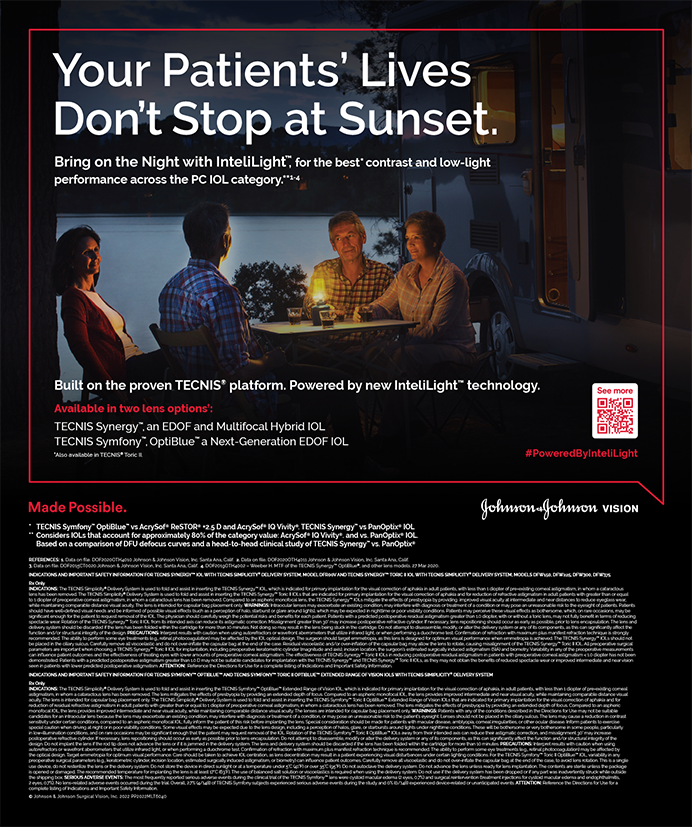
I started in ophthalmology at what I feel to be an important juncture in the evolution of pharmacology and technology. In 1987, my colleagues and I were witnessing a transition from extracapsular cataract extraction to phacoemulsification, and work on a new technology called an excimer laser for the treatment of refractive errors was coming to fruition. A year earlier, the FDA approved the first nonsteroidal anti-inflammatory drug (NSAID) to prevent intraoperative miosis: Ocufen (flurbiprofen sodium 0.03%; Allergan).1 We soon realized that the agent also helped control inflammation and pain after surgery.
AT A GLANCE
- Patients want rapid, painless visual recovery after refractive and refractive cataract surgery. Nonsteroidal anti-inflammatory drugs achieve both goals.
- In the author’s experience, branded nonsteroidal anti-inflammatory drugs are more effective than generic agents.
I finished my fellowship and had the opportunity to participate in studies of Voltaren (diclofenac sodium 0.1%; Novartis Ophthalmics), which the FDA approved for intraoperative pain management in 1991 and later for postoperative pain management. The agency approved Acular (ketorolac tromethamine 0.5%; Allergan) for allergic conjunctivitis in 1992 and later for the management of postoperative inflammation. After additional studies, the drug was also approved for treating pain after PRK in 1998.
As I reflect on the history of NSAIDs and my experience with them, a few points stand out.
SPEED MATTERS
Some researchers have attempted to demonstrate the benefit of NSAIDs, whereas others have balked at supporting the routine use of these drugs.2-7 The most recent review by Kim and colleagues concluded, “Although dosing of NSAIDs before surgery may hasten the speed of visual recovery in the first several weeks after cataract surgery, there is no evidence that this practice affects long-term visual outcomes.”8
Their statement exactly reflects my sentiments. Current refractive and refractive cataract surgery demands a “hastened” visual recovery. Patients do not want to see in a week or a month; they want to see immediately, and if they develop a complication such as cystoid macular edema, they believe the procedure has failed.
Through the years, I have continued to refer to a study authored by Wittpenn and colleagues.9 I admire its protocol and the thought invested in its design. I have always been interested in outcomes and ways to improve vision rapidly. These researchers showed how using NSAIDs rapidly resulted in better vision with reduced side effects.
I should add that patients also do not want pain. Simply put, NSAIDs prevent pain.10-15
THE ELEPHANT IN THE ROOM
After a generic formulation of diclofenac became available, patients were referred to me with corneal melts. It was not a pleasant experience—least of all for the patients.
Studies have shown that generic ophthalmic agents do not work as well as their branded counterparts,16,17 but rising medical costs will lead to more generics. In my experience, generic corticosteroids and NSAIDs are less effective than their branded counterparts. Some surgeons are willing to accept a subpar result in a certain percentage of their patients because of the drugs’ cost, but that is not how I practice medicine.
AN OUNCE OF PREVENTION
In the past 10 years, industry has introduced NSAIDs that require less frequent administration, have greater potency for decreasing inflammation and pain, carry fewer side effects, and basically offer better penetration and effect. The most recent additions are Prolensa (bromfenac sodium 0.07%; Bausch + Lomb), Ilevro (nepafenac 0.3%; Alcon), and BromSite (bromfenac 0.075%; Sun Pharma).
To my mind, it is easier to prevent inflammation than to treat it at any stage. Prostaglandins play a critical role in the generation of the inflammatory response, and NSAIDs attempt to reduce prostaglandin levels before the cascade begins. That is one reason I prefer to begin therapy prior to surgery.
During my career, I have prescribed all of the available NSAIDs. Experience has taught me that patients want to see quickly and to use drops as infrequently as possible. For these reasons, I have prescribed bromfenac sodium 0.07% at a once-daily dosage since the drug’s approval. Most of my patients can obtain this medication through their insurance plans, and my staff appreciate the absence of calls about filling the prescription. The large bottle gives me confidence that my patients will have enough drops to complete treatment, whether their surgery was routine or complex. So far, adherence to prescribed therapy has not been a problem, and postoperative recovery has been rapid.
CONCLUSION
In their article, Kim and colleagues stated, “Although long-term visual acuity (≥ 3 months) after cataract surgery is an important clinical measure of a therapeutic intervention, this assessment was not designed to comment on the rationale and potential value of NSAID therapy in preventing [cystoid macular edema] soon after surgery and the patient satisfaction and quality-of-life improvement associated with more rapid visual rehabilitation.”8 For me, it is a straightforward matter. My patients have come to expect simple things from me as a surgeon. They want me to treat them as if they were family. They want to see immediately and without complications. Most importantly, they expect to have a wonderful experience, which means no pain. I would want the same. That is why I routinely prescribe a brand-name NSAID after refractive and refractive cataract surgery.
1. Keates RH, McGowan KA. Clinical trial of flurbiprofen to maintain pupillary dilation during cataract surgery. Ann Ophthalmol. 1984;16(10):919-921.
2. Flach AJ. Topical nonsteroidal antiinflammatory drugs in ophthalmology. Int Ophthalmol Clin. 2002;42(1):1-11.
3. Schalnus R. Topical nonsteroidal anti-inflammatory therapy in ophthalmology. Ophthalmologica 2003;217(2):89-98.
4. Colin J. The role of NSAIDs in the management of postoperative ophthalmic inflammation. Drugs. 2007;67(9):1291-1308.
5. Kim SJ, Flach AJ, Jampol LM. Nonsteroidal anti-inflammatory drugs in ophthalmology. Surv Ophthalmol. 2010;55(2):108–133.
6. Shorstein NH, Liu L, Waxman MD, Herrinton LJ. Comparative effectiveness of three prophylactic strategies to prevent clinical macular edema following phacoemulsification surgery. Ophthalmology. 2015;122(12):2450-2456.
7. VHA Pharmacy Benefits Management Services and the Medical Advisory Panel. Drug Class Review: Ophthalmic Nonsteroidal Anti-Inflammatory Drugs (NSAIDs). July 2009. https://www.pbm.va.gov/clinicalguidance/drugclassreviews/OphthalmicNonsteroidalAntiInflammatoryDrugsNSAIDsReview.pdf. Accessed June 9, 2017.
8. Kim SJ, Schoenberger SD, Thorne JE, et al. Topical nonsteroidal anti-inflammatory drugs and cataract surgery: a report by the American Academy of Ophthalmology. Ophthalmology. 2015;122(11): 2159-2168.
9. Wittpenn JR, Silverstein S, Heier J, et al; Acular LS for Cystoid Macular Edema (ACME) Study Group. A randomized, masked comparison of topical ketorolac 0.4% plus steroid vs steroid alone in low-risk cataract surgery patients. Am J Ophthalmol. 2008;146(4):554-560.
10. Weinstock VM, Weinstock DJ, Weinstock SJ. Diclofenac and ketorolac in the treatment of pain after photorefractive keratectomy. J Refract Surg. 1996;12(7):792-794.
11. McDonald MB, Brint SF, Caplan DI, et al. Comparison of ketorolac tromethamine, diclofenac sodium, and moist drops for ocular pain after radial keratotomy. J Cataract Refract Surg. 1999;25(8):1097-1108.
12. Narváez J, Krall P, Tooma TS. Prospective, randomized trial of diclofenac and ketorolac after refractive surgery. J Refract Surg. 2004;20(1):76-78.
13. Colin J, Paquette B. Comparison of the analgesic efficacy and safety of nepafenac ophthalmic suspension compared with diclofenac ophthalmic solution for ocular pain and photophobia after excimer laser surgery: a phase II, randomized, double-masked trial. Clin Ther. 2006;28(4):527-536.
14. Trattler W, McDonald M. Double-masked comparison of ketorolac tromethamine 0.4% versus nepafenac sodium 0.1% for postoperative healing rates and pain control in eyes undergoing surface ablation. Cornea. 2007;26(6):665-669.
15. Donnenfeld ED, Holland EJ, Durrie DS, Raizman MB. Double-masked study of the effects of nepafenac 0.1% and ketorolac 0.4% on corneal epithelial wound healing and pain after photoreactive keratectomy. Adv Ther. 2007;24(4):852-862.
16. Marlowe ZT, Davio SR. Dose uniformity of loteprednol etabonate ophthalmic gel (0.5%) compared with branded and generic prednisolone acetate ophthalmic suspension (1%). Clin Ophthalmol. 2014;8:23-29.
17. Stringer W, Bryant R. Dose uniformity of topical corticosteroid preparations: difluprednate ophthalmic emulsion 0.05% versus branded and generic prednisolone acetate ophthalmic suspension 1%. Clin Ophthalmol. 2010;4:1119-1124.




